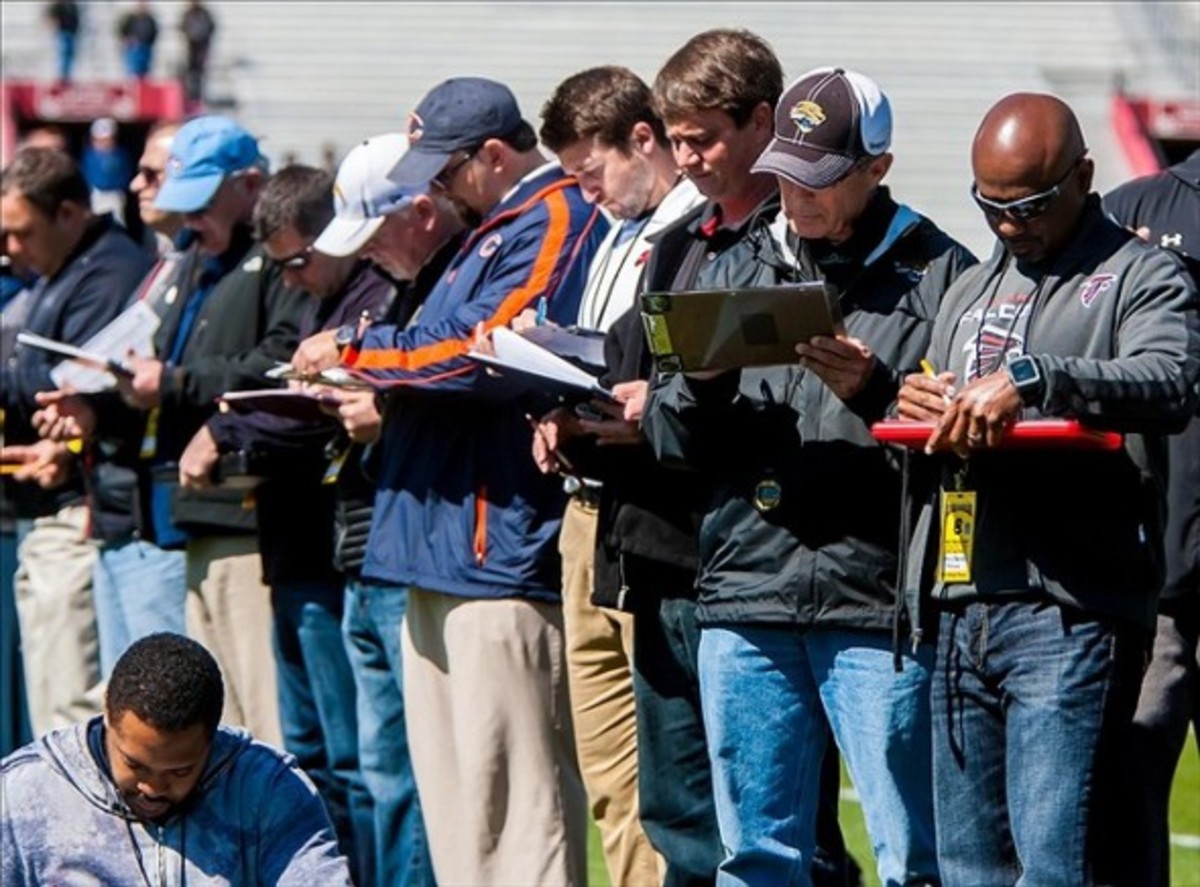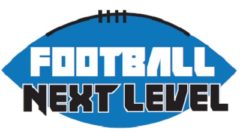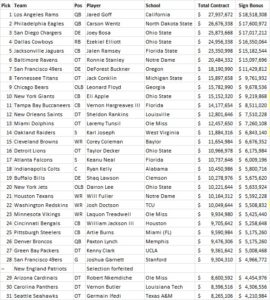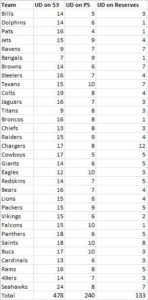Tag: NFL Prospect
Why “Spring Grades” are Important

By Justin VanFulpen
When NFL scouts from the two scouting services BLETSO and National go into a school to do their junior evaluation they are looking to grade the NFL draft prospects for the next year’s draft but also to eliminate players as guys who can’t play in the NFL. The scouts give those players “reject” grades so scout in the fall don’t have to spend time on players who are deemed not NFL players.
The scouting services grade over 13,000 senior college football players each year at all levels of football and normally there are around 600 with draft able or free-agent grades. True do players with “reject” grades get draft? Yes but it is few and far between.
Spring grades are important for a number of reasons:
1. It is a road map for NFL scouts in the fall to where they should spend their most time.
2. National Scouting runs the NFL Combine so if a player has a good spring grade he is more likely to get invited then if he doesn’t.
3. All-Star games try to get their hands on these grades and use them when they start to invite players to their games.
True as a Senior what you do on the field is most import to your final NFL draft grade, but it doesn’t hurt to start with a good spring grade going into your Senior season.
Money break down of the NFL Draft
By Justin VanFulpen
Tomorrow is the first round of the 2017 NFL Draft here is a look back at last year’s draft (2016) in terms of the average guaranteed dollars by round.
1st Round = $13,518,446
2nd Round = $3,024,333
3rd Round = $755,602
4th Round = $524,372
5th Round = $231,976
6th Round = $124,830
7th Round = $72,496
So you can see there is a big drop off from the first round to the second round in terms of guaranteed dollars. Below you will see a breakdown of all last year’s first round picks in terms of total contract (all 1st round pick total contract is guaranteed) and the signing bonus.
So you see there is a huge drop off in terms of your total contact from being the 1st pick of the draft to even being the 16th pick in the 1st round. Between Jared Goff to Taylor Decker there is a difference of almost $17 million dollars.
Because of amount of money that is on the line that why teams do as much work on not only the playing ability but the personal and back ground of a prospect. We see this year two prospect have had off the field issues weeks leading up to the draft that could cost them a lot of money in CB Gareon Conley, Ohio State (one time projected as high as top 15 overall ) and DT Caleb Brantley, Florida (one time projected in the 1st round). We will see what end happens with these two prospects when it is all said and done. So as an NFL prospect you need to remember it is not just about how good of a player you are or can be on the field.
Undrafted: Doesn’t mean a player won’t make it in the NFL
When the NFL Draft comes around every April every college football player that is eligible is hoping that they will get drafted somewhere in the 7 round draft. With over 1,500 eligible players and only 256 draft slots that can’t happen. After the NFL Draft teams will sign undrafted rookie free-agents and it gives them an opportunity to make the teams 53 man roster, some other teams 53 man roster or a practice squad. With the NFL season about to kickoff let look at the impact that undrafted rookie free-agents have on NFL rosters.
As of September 7, 2016 there is 478 players on a 53 man roster that where not drafted. So 28% of the 32 NFL teams 53 man rosters are made of undrafted free-agents. 61 of these players are rookies.
There are 240 undrafted players that are on practice squads. Teams are allowed a max of 10 players on a practice squad, so 75% of the NFL’s practice squads are made up of undrafted players.
NFL teams spend millions of dollars on scouting players for the draft but they are unable to be prefect in their selection of players. When the draft comes everyone has an opinion on what players will get drafted and who will make the 53 man roster but the NFL business is unpredictable and that is one reason why people love it.
A full breakdown of all 32 NFL teams and undrafted players:
Role of an NFL Agent
By Justin VanFulpen
Impact of Social Media and NFL Draft Prospects

By Justin VanFulpen
In the past few years social media has exploded and more and more corporate America is reviewing candidates for jobs social media profiles and making hiring decisions based on what they find on someone’s Facebook, Twitter, Instagram, Snapchat, etc. This has now made its way to the NFL Draft process and it is something some NFL teams are taking to a scientific measurable level.
NFL teams are creating a “social media profile” on NFL draft prospects as well as their regular football profile that included football skills on film, medical and character. This social media profile is looking to see what the prospects are tweeting about, what they are posting, etc. Things that they are looking for is how much does the prospect post something about football? Are there posts about drugs, weapons, or alcohol? Does the prospect post things degrading women? Some NFL teams will use pie graphs to show the percentage of things that the prospect posts about.
How far are NFL teams going back to research? Well one NFL team that I talked to said that they looked all the way back at a tweet QB Jameis Winston had tweeted in high school. Yes, high school.
“Our job now as scouts is not just see if the guy can play but every aspect of his life and that now includes his social media and what he post, as what his post is most likely what is important to him as a person. We are now taking it to a level of measuring that.” said one NFL scout.
As we saw play out this past April draft with former Ole Miss and current Miami Dolphins OT Laremy Tunsil social media was hacked and a video and screen shot of texts were posted. Tunsil’s fall from the draft’s projected No. 3 pick to No. 13 cost him at least $10 million in guaranteed signing bonuses. True Tunsil’s social media profiles we hacked by what was believed someone who Tunsil had given access to his profiles in the past.
With this social media analytics and data what NFL teams are trying to find out is, one does the prospect love football and two is he a good guy and can we trust him. Everyone need to know what they post on social media could be viewed differently by different people. True what someone post on social media doesn’t give the full picture but it is a tool that NFL teams are trying to use to make better personal decisions.
Social media can be used for positives things like building one’s brand, marketing, engaging with fans, supporting causes and much more but it can have a negative effect as well and once something is posted it can’t be taken back even if deleted because with the notoriety someone will screen shot it and it will live on.
NFL Draft: “All-Star Games” and why they matter

By Justin VanFulpen
One of the biggest things in the pre-draft process is the different all-star games. I have had the opportunity to be involved with 6 College Football all-star games. Five Texas vs. the Nation games and as well as the Player All-Star Classic in 2012, mainly working with the player personnel but also having other duties.
This past February at the NFL Combine, former NFL GM Ray Farmer said about All-Star Games.
“I put more stock in that then combine stuff, the reason I do that, it’s ball… All-Star Games matter because it is good on good.”
College football all-star games are about giving players an opportunity to show their skills in front of NFL scouts. In this environment where player come from all levels of competition the NFL scouts are evaluating not only the one-on-one and team practices but how fast can a player pick the offense or defense that is being installed since everything is done within that game week.
Small school prospects that get into one of the major all-star games have a great ability to help themselves in the draft process because it shows scouts that the level of competition is not too high for them since that will be one of the biggest questions mark for that prospect to answer.
We saw this past year at the Senior Bowl QB Carson Wentz from North Dakota State who end up as the number two pick overall by the Philadelphia Eagles raise his draft stock from his week of practice at the Senior Bowl.
The question always comes up from coaches, players, parents, agents, etc. – How does a player get invited to play in a game? I had an opportunity to be in charge of the personnel and like all the other people in the all-star game business we are looking for the best player that will have an opportunity to get drafted. Since the life blood of an all-star game is sponsorship and most sponsors are looking to get close to NFL players or be able to say that they are involved with NFL prospects without having to spend the top dollars to be an official NFL sponsor.
But what I always tell people asking that question that communication is key with the personnel directors of the game or their staff. Sometimes players will miss out on an opportunity to play in an all-star game because they don’t get back with an all-star game to let them know they are interested in playing in the game because they are waiting to get an invite to a “bigger” game.
Since the Senior Bowl is by the far the number one all-star game they have the lead when it comes to what prospects go where. If a player gets invited to the Senior Bowl most of the time they are pulling out of whatever all-star game they are in and going to that game. Since that is the case and invites are kept close to the vest it causes all the other all-star games to continuously change their roster.
All-Star games start sending out invites in mid to late October and each game does it different as far as inviting players. Some email the player directly other will send the invite to the school and have the coaches give it to the players.
My advice to players is accept the invite when you get it and get it back to the game if then you get invited to a “bigger” game, just communicate with the game you had already accepted and just let them know in a timely manner so they can invite someone else.
2016 NFL Draft: Testing Averages per Position

By Justin VanFulpen
With the 2016 NFL Draft in the books here is a look at the average height, weight, 40, Vertical Jump, Short shuttle, and 3 cone drill by position of players that were drafted.
QBs: 6037 226 – 4.84 (40) – 30.9’’ (Vertical) – 4.31 (20 yard shuttle) – 7.15 (3-Cone)
Fastest 40 – 4.78 (Hackenburg & Hogan)
Highest Vertical – 36’’ (Lynch & Jones)
Fastest Short Shuttle – 4.15 (Wentz)
3 Cone – 6.86 (Wentz)
RBs: 5112 214 – 4.49 (40) – 35.2’’ (Vertical) – 4.28 (20 yard shuttle) – 7.04 (3-Cone)
Fastest 40 – 4.31 (Drake)
Highest Vertical – 41.5’’ (Lasco)
Fastest Short Shuttle – 4.20 (Taylor & DeAndre Washington)
3 Cone – 6.83 (Smallwood)
FBs: 6008 233 – 4.73 (40) – 35.3’’ (Vertical) – 4.25 (20 yard shuttle) – 7.20 (3-Cone)
Fastest 40 – 4.60 (Vitale)
Highest Vertical – 38.5’’ (Vitale)
Fastest Short Shuttle – 4.12 (Vitale)
3 Cone – 7.12 (Vitale)
WRs: 6004 199 – 4.48 (40) – 35.2’’ (Vertical) – 4.24 (20 yard shuttle) – 6.92 (3-Cone)
Fastest 40 – 4.29 (Hill)
Highest Vertical – 41’’ (Doctson & Shepard)
Fastest Short Shuttle – 4.06 (Hill)
3 Cone – 6.53 (Hill)
TEs: 6045 252 – 4.75 (40) – 32.9’’ (Vertical) – 4.27 (20 yard shuttle) – 7.00 (3-Cone)
Fastest 40 – 4.64 (Adams)
Highest Vertical – 40’’ (DeValve)
Fastest Short Shuttle – 4.15 (DeValve)
3 Cone – 6.88 (Adams)
OTs: 6055 310 – 5.17 (40) – 28.2’’ (Vertical) – 4.73 (20 yard shuttle) – 7.90 (3-Cone)
Fastest 40 – 4.94 (Spriggs)
Highest Vertical – 32.5’’ (Ifedi)
Fastest Short Shuttle – 4.44 (Spriggs)
3 Cone – 7.63 (Conklin)
OGs: 6043 304 – 5.19 (40) – 27.3’’ (Vertical) – 4.72 (20 yard shuttle) – 7.72 (3-Cone)
Fastest 40 – 4.95 (Thuney)
Highest Vertical – 33’’ (McGovern)
Fastest Short Shuttle – 4.54 (Thuney)
3 Cone – 7.32 (Whitehair)
Cs: 6037 301 – 5.19 (40) – 27.5’’ (Vertical) – 4.64 (20 yard shuttle) – 7.54 (3-Cone)
Fastest 40 – 5.13 (Glasgow)
Highest Vertical – 30’’ (Kelly)
Fastest Short Shuttle – 4.52 (Seumalo)
3 Cone – 7.40 (Seumalo)
DEs: 6044 273 – 4.83 (40) – 32.7’’ (Vertical) – 4.37 (20 yard shuttle) – 7.29 (3-Cone)
Fastest 40 – 4.59 (Tapper)
Highest Vertical – 37.5’’ (Holmes)
Fastest Short Shuttle – 4.00 (McCalister)
3 Cone – 6.89 (Bosa)
DTs: 6028 304 – 5.07 (40) – 28.5’’ (Vertical) – 4.65 (20 yard shuttle) – 7.29 (3-Cone)
Fastest 40 – 4.69 (Ridgeway)
Highest Vertical – 35’’ (Nkemdiche)
Fastest Short Shuttle – 4.50 (Day)
3 Cone – 7.25 (Onyemata)
OLBs: 6020 241 – 4.66 (40) – 34.1’’ (Vertical) – 4.36 (20 yard shuttle) – 7.18 (3-Cone)
Fastest 40 – 4.42 (Weatherly)
Highest Vertical – 41’’ (Nicolas)
Fastest Short Shuttle – 4.20 (Lee & Correa)
3 Cone – 6.65 (James)
ILBs: 6010 240 – 4.72 (40) – 32.4’’ (Vertical) – 4.33 (20 yard shuttle) – 7.08 (3-Cone)
Fastest 40 – 4.57 (Walker)
Highest Vertical – 37.5’’ (Walker)
Fastest Short Shuttle – 4.00 (Vigil)
3 Cone – 6.73 (Vigil)
CBs: 5114 194 – 4.47 (40) – 35.8’’ (Vertical) – 4.21 (20 yard shuttle) – 7.00 (3-Cone)
Fastest 40 – 4.33 (Brown)
Highest Vertical – 41.5’’ (Ramsey & Reed)
Fastest Short Shuttle – 3.98 (Hargreaves)
3 Cone – 6.60 (Caldwell)
Ss: 6004 204 – 4.56 (40) – 36.1’’ (Vertical) – 4.21 (20 yard shuttle) – (3-Cone)
Fastest 40 – 4.42 (Grugier-Hill)
Highest Vertical – 40.5’’ (Nicolas)
Fastest Short Shuttle – 4.20 (Frazier & Fejedelem)
3 Cone – 6.58 (Simmons)
2016 NFL Draft: NFL Scouting Combine Results

By Justin VanFulpen
In the football business one of the closely guarded secrets before the official list is released is who is getting invited to the NFL Combine. The NFL Combine is run by National Scouting and has become a televised event by the NFL Network. For more information about how the NFL Combine invites work you can check out my article from a year ago: NFL Draft: NFL Combine just part of the process.
Now that the 2016 NFL Draft is in the books we can look at the results. This year there were 332 players invited to the NFL Combine and their where 37 players that were drafted that did NOT go to the NFL Combine. Break down as far as rounds go:
3rd round – 1 player
4th round – 2 players
5th round – 5 players
6th round – 17 players
7th round – 12 players
So 116 players that were invited to this year’s NFL Combine were not drafted. So the percentage of players that were drafted that were invited to the NFL Combine was 65%, so it is far from a guarantee if you are invited that you will get selected in the NFL Draft. Last year it was 66.7% of the players that were at the NFL Combine where drafted.
Former NFL GM Ray Farmer talks about the NFL Draft and the process
Highlights from Former NFL GM and Scout Ray Farmer talking about the NFL Draft and the process at Inside the League Event at 2016 NFL Combine. Ray Farmer was a 4th round draft pick, worked for the Atlanta Falcons as a scout, Kansas City Chiefs as Director of Pro Personnel, and the Cleveland Browns as General Manager.



